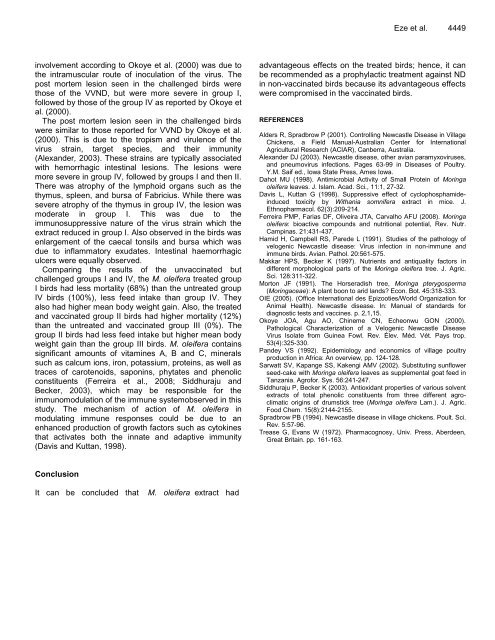Download Complete Issue (4740kb) - Academic Journals
Download Complete Issue (4740kb) - Academic Journals
Download Complete Issue (4740kb) - Academic Journals
Create successful ePaper yourself
Turn your PDF publications into a flip-book with our unique Google optimized e-Paper software.
involvement according to Okoye et al. (2000) was due to<br />
the intramuscular route of inoculation of the virus. The<br />
post mortem lesion seen in the challenged birds were<br />
those of the VVND, but were more severe in group I,<br />
followed by those of the group IV as reported by Okoye et<br />
al. (2000).<br />
The post mortem lesion seen in the challenged birds<br />
were similar to those reported for VVND by Okoye et al.<br />
(2000). This is due to the tropism and virulence of the<br />
virus strain, target species, and their immunity<br />
(Alexander, 2003). These strains are typically associated<br />
with hemorrhagic intestinal lesions. The lesions were<br />
more severe in group IV, followed by groups I and then II.<br />
There was atrophy of the lymphoid organs such as the<br />
thymus, spleen, and bursa of Fabricius. While there was<br />
severe atrophy of the thymus in group IV, the lesion was<br />
moderate in group I. This was due to the<br />
immunosuppressive nature of the virus strain which the<br />
extract reduced in group I. Also observed in the birds was<br />
enlargement of the caecal tonsils and bursa which was<br />
due to inflammatory exudates. Intestinal haemorrhagic<br />
ulcers were equally observed.<br />
Comparing the results of the unvaccinated but<br />
challenged groups I and IV, the M. oleifera treated group<br />
I birds had less mortality (68%) than the untreated group<br />
IV birds (100%), less feed intake than group IV. They<br />
also had higher mean body weight gain. Also, the treated<br />
and vaccinated group II birds had higher mortality (12%)<br />
than the untreated and vaccinated group III (0%). The<br />
group II birds had less feed intake but higher mean body<br />
weight gain than the group III birds. M. oleifera contains<br />
significant amounts of vitamines A, B and C, minerals<br />
such as calcum ions, iron, potassium, proteins, as well as<br />
traces of carotenoids, saponins, phytates and phenolic<br />
constituents (Ferreira et al., 2008; Siddhuraju and<br />
Becker, 2003), which may be responsible for the<br />
immunomodulation of the immune systemobserved in this<br />
study. The mechanism of action of M. oleifera in<br />
modulating immune responses could be due to an<br />
enhanced production of growth factors such as cytokines<br />
that activates both the innate and adaptive immunity<br />
(Davis and Kuttan, 1998).<br />
Conclusion<br />
It can be concluded that M. oleifera extract had<br />
Eze et al. 4449<br />
advantageous effects on the treated birds; hence, it can<br />
be recommended as a prophylactic treatment against ND<br />
in non-vaccinated birds because its advantageous effects<br />
were compromised in the vaccinated birds.<br />
REFERENCES<br />
Alders R, Spradbrow P (2001). Controlling Newcastle Disease in Village<br />
Chickens, a Field Manual-Australian Center for International<br />
Agricultural Research (ACIAR), Canberra, Australia.<br />
Alexander DJ (2003). Newcastle disease, other avian paramyxoviruses,<br />
and pneumovirus infections. Pages 63-99 in Diseases of Poultry.<br />
Y.M. Saif ed., Iowa State Press, Ames Iowa.<br />
Dahot MU (1998). Antimicrobial Activity of Small Protein of Moringa<br />
oleifera leaves. J. Islam. Acad. Sci., 11:1, 27-32.<br />
Davis L, Kuttan G (1998). Suppressive effect of cyclophosphamideinduced<br />
toxicity by Withania somnifera extract in mice. J.<br />
Ethnopharmacol. 62(3):209-214.<br />
Ferreira PMP, Farias DF, Oliveira JTA, Carvalho AFU (2008). Moringa<br />
oleifera: bioactive compounds and nutritional potential, Rev. Nutr.<br />
Campinas. 21:431-437.<br />
Hamid H, Campbell RS, Parede L (1991). Studies of the pathology of<br />
velogenic Newcastle disease: Virus infection in non-immune and<br />
immune birds. Avian. Pathol. 20:561-575.<br />
Makkar HPS, Becker K (1997). Nutrients and antiquality factors in<br />
different morphological parts of the Moringa oleifera tree. J. Agric.<br />
Sci. 128:311-322.<br />
Morton JF (1991). The Horseradish tree, Moringa pterygosperma<br />
(Moringaceae): A plant boon to arid lands? Econ. Bot. 45:318-333.<br />
OIE (2005). (Office International des Epizooties/World Organization for<br />
Animal Health). Newcastle disease. In: Manual of standards for<br />
diagnostic tests and vaccines. p. 2,1,15.<br />
Okoye JOA, Agu AO, Chineme CN, Echeonwu GON (2000).<br />
Pathological Characterization of a Velogenic Newcastle Disease<br />
Virus Isolate from Guinea Fowl. Rev. Élev. Méd. Vét. Pays trop.<br />
53(4):325-330.<br />
Pandey VS (1992). Epidemiology and economics of village poultry<br />
production in Africa: An overview, pp. 124-128.<br />
Sarwatt SV, Kapange SS, Kakengi AMV (2002). Substituting sunflower<br />
seed-cake with Moringa oleifera leaves as supplemental goat feed in<br />
Tanzania. Agrofor. Sys. 56:241-247.<br />
Siddhuraju P, Becker K (2003). Antioxidant properties of various solvent<br />
extracts of total phenolic constituents from three different agroclimatic<br />
origins of drumstick tree (Moringa oleifera Lam.). J. Agric.<br />
Food Chem. 15(8):2144-2155.<br />
Spradbrow PB (1994). Newcastle disease in village chickens. Poult. Sci.<br />
Rev. 5:57-96.<br />
Trease G, Evans W (1972). Pharmacognosy, Univ. Press, Aberdeen,<br />
Great Britain. pp. 161-163.

















